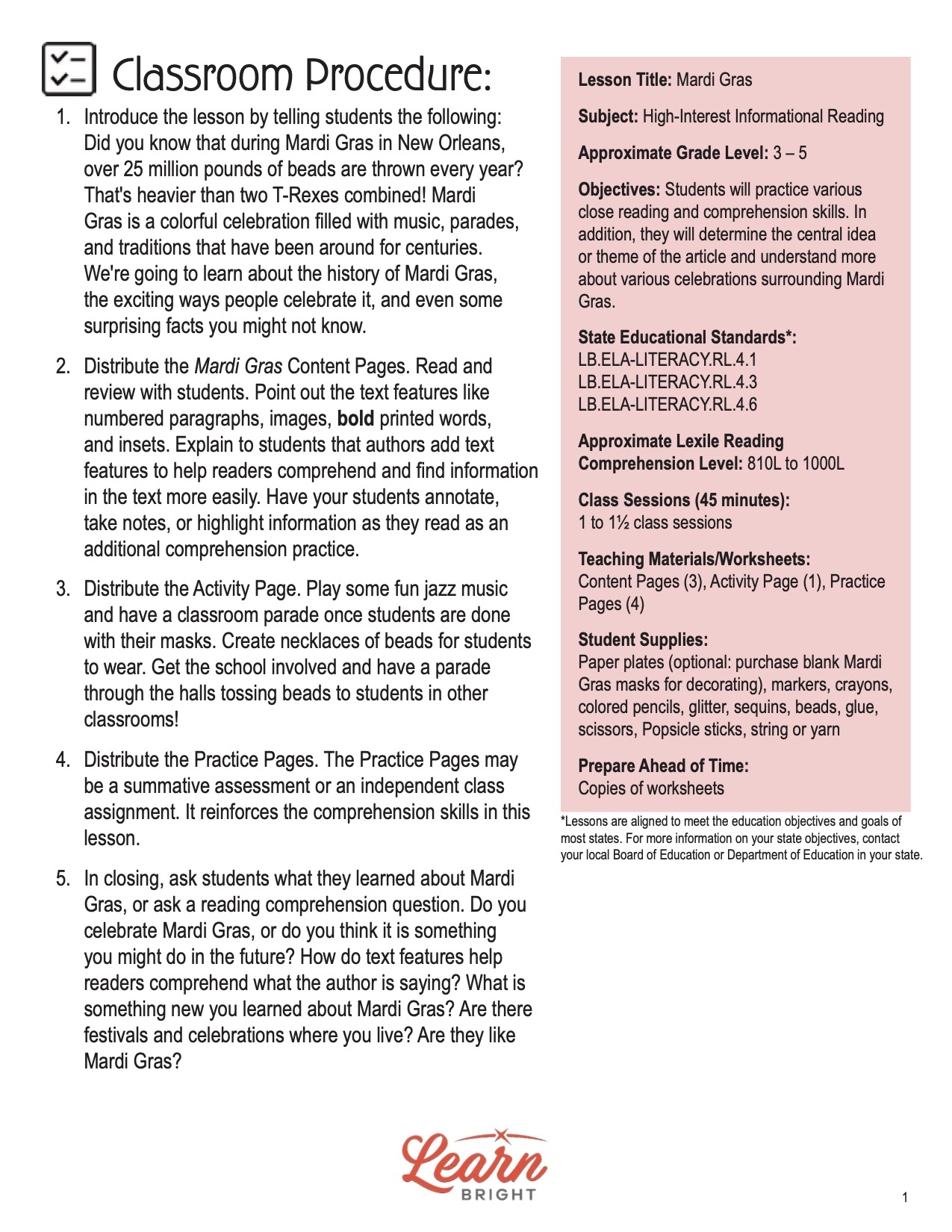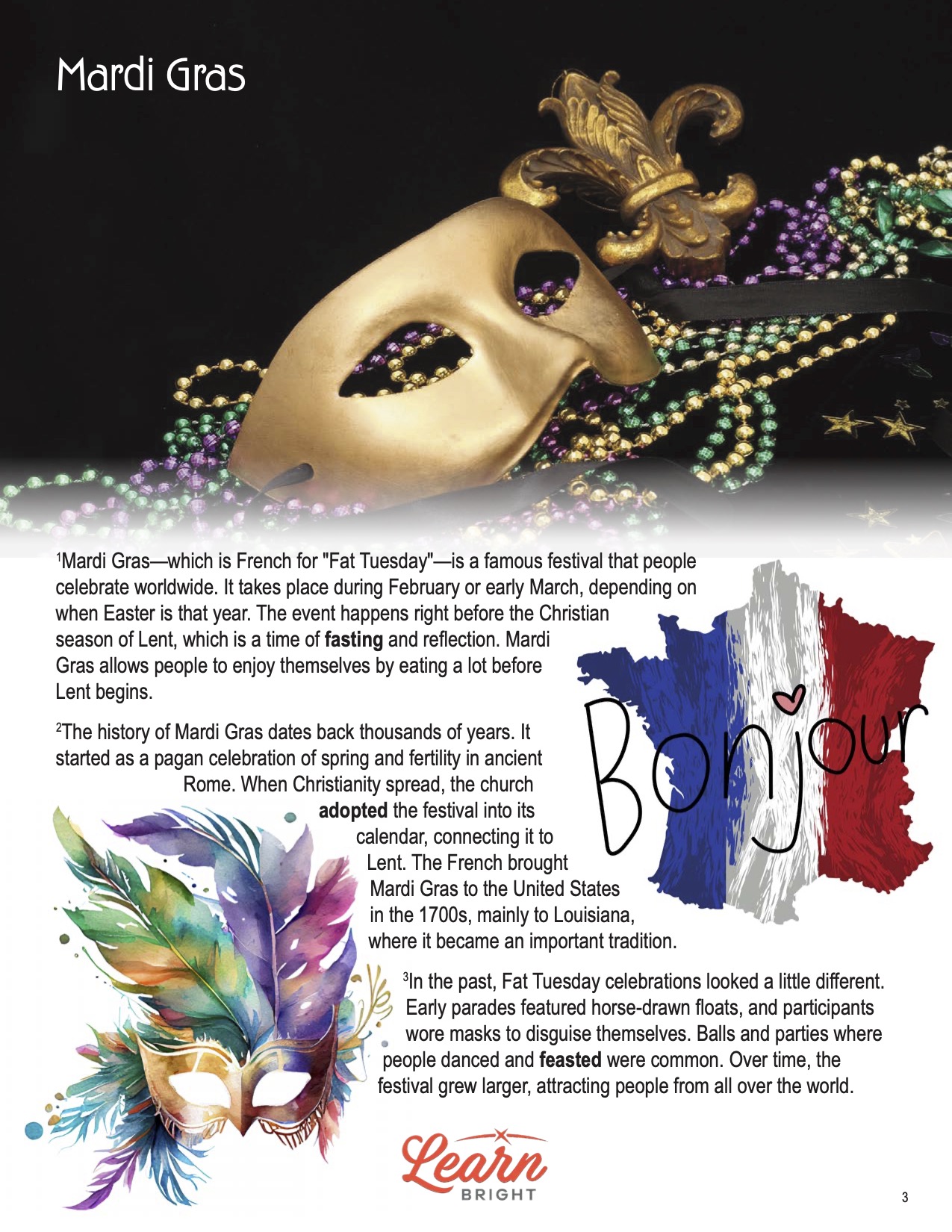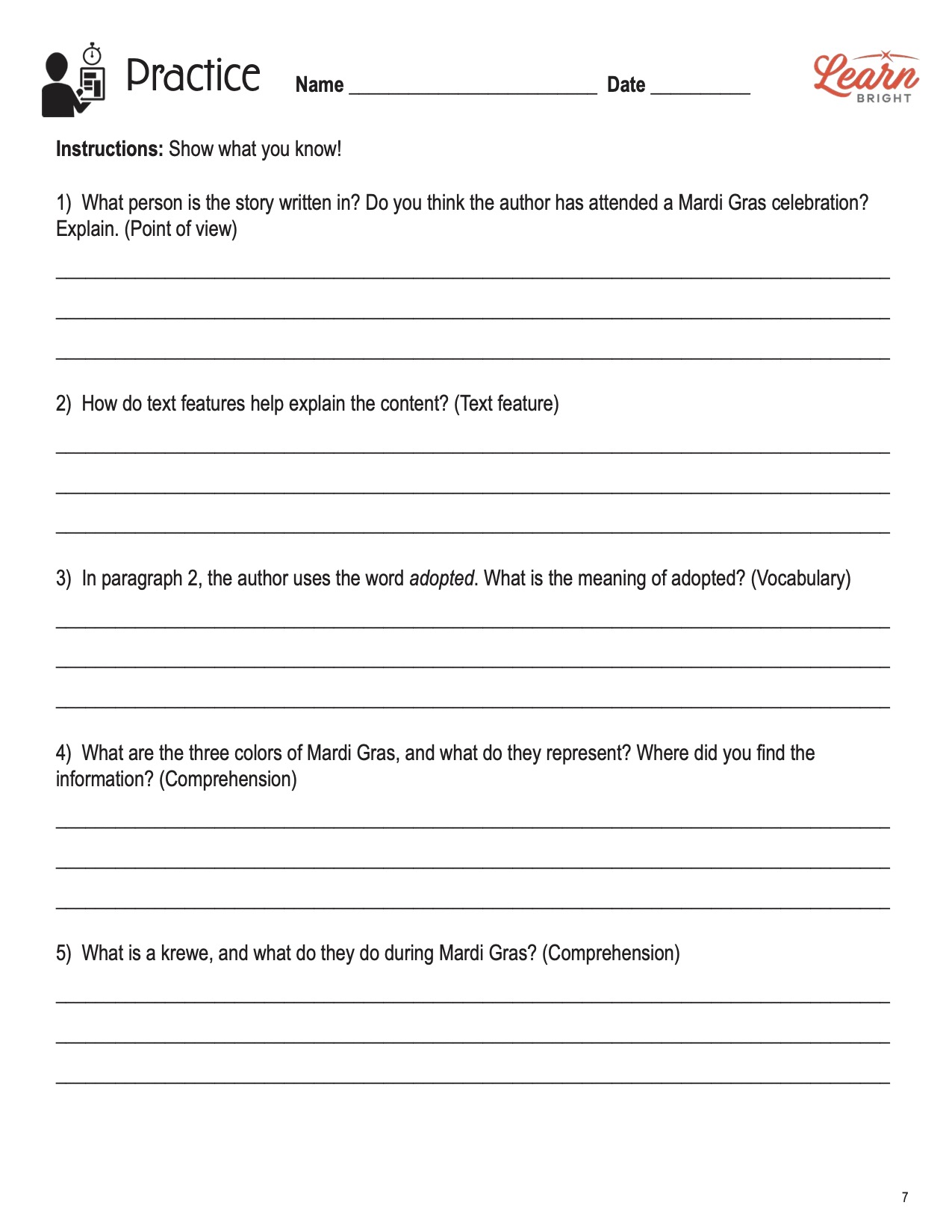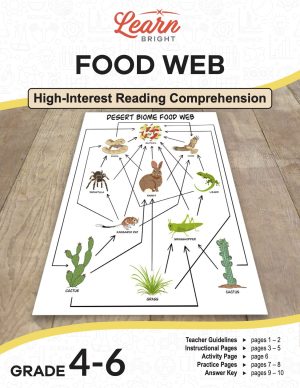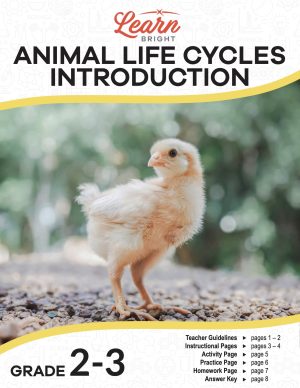Description
What our Mardi Gras lesson plan includes
Lesson Objectives and Overview: Mardi Gras is a high-interest reading comprehension lesson plan. As such, students will practice various close reading and comprehension skills. In addition, they will learn about this fun and recognizable festival. This lesson is for students in 3rd grade, 4th grade, and 5th grade.
Classroom Procedure
Every lesson plan provides you with a classroom procedure page that outlines a step-by-step guide to follow. You do not have to follow the guide exactly. The guide helps you organize the lesson and details when to hand out worksheets. It also lists information in the yellow box that you might find useful. You will find the lesson objectives, state standards, and number of class sessions the lesson should take to complete in this area. In addition, it describes the supplies you will need as well as what and how you need to prepare beforehand. For the activity, you’ll need paper plates (or optional: purchase blank Mardi Gras masks for decorating), markers, crayons, colored pencils, glitter, sequins, beads, glue, scissors, Popsicle sticks, and string or yarn.
Teacher Notes
The teacher notes page provides an extra paragraph of information to help guide the lesson and remind you what to focus on. It explains that you can teach this lesson in a whole-class setting or as an independent, small-group activity. The blank lines on this page are available for you to write out thoughts and ideas you have as you prepare the lesson.
MARDI GRAS LESSON PLAN CONTENT PAGES
History of Mardi Gras
The Mardi Gras lesson plan contains two content pages. Mardi Gras—which is French for “Fat Tuesday”—is a famous festival that people celebrate worldwide. It takes place during February or early March, depending on when Easter is that year. The event happens right before the Christian season of Lent, which is a time of fasting and reflection. Mardi Gras allows people to enjoy themselves by eating a lot before Lent begins.
The history of Mardi Gras dates back thousands of years. It started as a pagan celebration of spring and fertility in ancient Rome. When Christianity spread, the church adopted the festival into its calendar, connecting it to Lent. The French brought Mardi Gras to the United States in the 1700s, mainly to Louisiana, where it became an important tradition.
In the past, Fat Tuesday celebrations looked a little different. Early parades featured horse-drawn floats, and participants wore masks to disguise themselves. Balls and parties where people danced and feasted were common. Over time, the festival grew larger, attracting people from all over the world.
Mardi Gras Floats
Today, people celebrate the festival in many places, but it is most famous in New Orleans, Louisiana. The parades feature massive floats of purple, green, and gold, the official colors of Mardi Gras. The colors represent justice, faith, and power. People in costumes throw beads, coins, and other trinkets, called throws, to the cheering crowds. Music fills the air as jazz bands march through the streets.
Mardi Gras floats are one of the most exciting parts of the festival, dazzling crowds with their size, creativity, and vibrant decorations. These floats are built on sturdy platforms, often using wood and metal frames. Tractors or trucks pull them along during parades. Many floats are decorated around a chosen theme, such as famous stories, cultural icons, or local traditions. Some floats are simple, while others are elaborate, featuring moving parts or giant sculptures. Months of hard work and artistic skill go into each float.
Not all floats are made by professional designers. Many are created by krewes. Krewes are groups of people that organize many of the parades and events during Mardi Gras. Each krewe has its own unique name, theme, and traditions. Its members work together throughout the year to design and build extravagant floats, create costumes, and plan performances. Many krewes also host balls and charity events, making them essential to the community. The most famous krewes, like Krewe of Rex and Krewe of Zulu, have been part of Mardi Gras for decades.
Beads and King Cakes
Throwing beads is what this festival is known for around the world. People on floats toss shiny necklaces to the cheering crowd. This fun tradition started long ago when krewes threw small gifts to parade watchers. Today, beads are the most popular, and they come in multiple colors and designs. Kids and adults wave, shout, and jump to catch the glittery throws. The streets of New Orleans explode with color during Fat Tuesday!
King cakes are a delicious and colorful treat to enjoy during Mardi Gras celebrations. These ring-shaped pastries are made from sweet, braided dough and decorated with purple, green, and gold icing. A tiny plastic baby is hidden inside each cake, symbolizing luck and prosperity. Whoever finds the baby in their slice is considered lucky but also must host the next Mardi Gras party.
While New Orleans is the most famous for the festival, a few other cities celebrate the festival with unique traditions. For example, Mobile—a city in Alabama—prides itself on being the birthplace of Mardi Gras in the United States. Its first celebration happened in 1703. In Galveston, Texas, celebrations include beachfront festivities, a dazzling fireworks display, and costume contests. Every Mardi Gras attracts thousands of visitors each year.
Fat Tuesday is more than just a festival—it’s a way for people to express themselves, connect with others, and honor a rich cultural history. Whether watching a parade, wearing a beautiful mask, eating king cake, or dancing to some live jazz, Mardi Gras is an experience you’ll never forget!
MARDI GRAS LESSON PLAN WORKSHEETS
The Mardi Gras lesson plan includes two worksheets: an activity worksheet and a practice worksheet. Each one will help students solidify their grasp of the material they learned throughout the lesson. You can refer to the classroom procedure guidelines to know when to hand out each worksheet.
MARDI GRAS MASK MAKING ACTIVITY WORKSHEET
For the activity, students will get to make their own Mardi Gras masks. The worksheet outlines the steps for making masks out of paper plates, but you can purchase pre-made blank masks for students to decorate if you prefer.
REVIEW PRACTICE WORKSHEET
The practice worksheet requires students to answer a series of 10 questions. These questions all relate to the content pages, so students will need to refer to them often for the answers. In addition, each question provides which reading tool the question corresponds to, such as text feature, vocabulary, or comprehension.
Worksheet Answer Keys
At the end of the lesson plan document is an answer key for the practice worksheet. The correct answers are all in red to make it easier for you to compare them with students’ responses. If you choose to administer the lesson pages to your students via PDF, you will need to save a new file that omits these pages. Otherwise, you can simply print out the applicable pages and keep these as reference for yourself when grading assignments.


